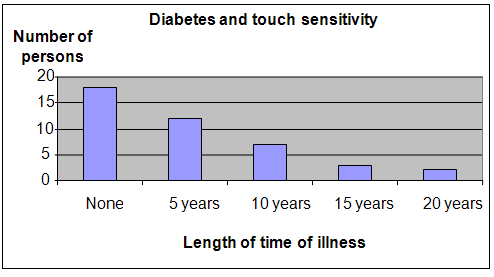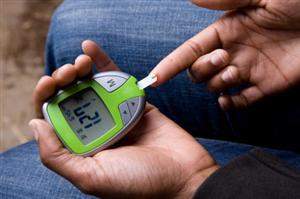| Complexity level: | 9 |
| Project cost ($): | 30 |
| Time required: | 1 week to prepare, 1 hour for science fair project |
| Material availability: | Requires the participation of diabetic patients. |
| Safety concerns: | Basic safety requirements |
Hypothesis
Persons suffering from diabetes for a longer period of time will have higher chances of being affected by diabetic neuropathy.
Overview
Diabetic neuropathy
Diabetic neuropathy is a disorder of the nerves that is caused by diabetes. People who suffer from diabetes will normally suffer from damage to their nerves. Some of the symptoms of diabetic neuropathy are numbness of hands, feet and legs. They also experience tingling and pain in their limbs.
Around 70% of diabetics are affected by diabetic neuropathy. Normally, the longer a person has been suffering from diabetes, the higher are his chances of suffering from diabetic neuropathy. Diabetic persons who are unable to control their sugar levels will also be at greater risk of developing diabetic neuropathy.
Diabetic neuropathy can be categorized into 4 types.
a. Peripheral neuropathy – causes numbness in the feet, leg, hand and arms.
b. Autonomic neuropathy – causes changes in bowel, bladder, digestion, sexual response and sweating.
c. Proximal neuropathy – causes pain in the hips, thighs and buttocks.
d. Focal neuropathy – muscle weakness and pain.
Scientific Terms
Materials
The materials required for the science fair project experiment:
- 1 piece of sand paper ISO Grit size P100
- 1 piece of sand paper ISO Grit size P80
- 1 piece of sand paper ISO Grit size P60
- 1 pair of scissors
- 20 participants without diabetes
- 20 participants suffering from diabetes for 5 years
- 20 participants suffering from diabetes for 10 years
- 20 participants suffering from diabetes for 15 years
- 20 participants suffering from diabetes for 20 years
- a black box
- 1 roll of masking tape
Procedure
1. For this science fair project, the independent variable is the roughness of the sandpaper and the length of time the participants have suffered from diabetes. The dependent variable is the participant’s choice of the roughest sand paper from the box. This is determined by observing which piece of sandpaper is picked by the participants. The constants (control variables) are the size of the box, the number of persons in each group and the size of the cut sandpaper.
2. The empty black box is sealed with masking tape and a round hole is cut in the box - just large enough for the participants to put their hand in and out.
3. The 3 types of sandpaper are cut to 50mm x 50mm size. Ensure you label the back of each piece with the correct ISO grit size. One piece of each type of sand paper is placed inside the black box.
4. The participants without diabetes are first tested one at a time. They are asked to put their hand inside the black box and take out the piece of sandpaper that they believe has the roughest surface. Once they have picked a piece, it is examined to see if they have taken out the right piece of paper (the piece with the highest ISO grit rating). The total number of participants that have taken out the correct sandpaper is recorded in the table given below.
5. Procedure 4 is repeated with the participants suffering from diabetes for 5 years, 10 years, 15 years and 20 years. The total number of participants that have selected the correct piece of sandpaper in each group is recorded in the table given below.

Results
The results showed that participants who had have suffered from diabetes for the greatest length of time were less likely to be able to correctly pick the sandpaper with the roughest surface.
|
Diabetes period |
None |
5 years |
10 years |
15 years |
20 years |
|
Number of persons picking correct sandpaper |
18 |
12 |
7 |
3 |
2 |
The chart below represents the results of our science project experiment.

Conclusion
Our hypothesis has been proven to be true. Persons suffering from diabetes for a longer period of time will have higher chances of being affected by diabetic neuropathy.
The first thing to do in treating diabetic neuropathy is to bring the blood sugar levels back down to normal. Regular exercise and a proper diet will help somewhat. Regular inspection of the feet is important to identify wounds in order to prevent infection.
Also consider
To improve the reliability and accuracy of our results, a larger sample of participants should be used.
This science fair project may be repeated, this time, by comparing the sensitivity of male and female participants.
Modify the science project experiment, involving persons with stage 1 and stage 2 diabetes.
References
Diabetic neuropathies – The nerve damage of Diabetes - http://diabetes.niddk.nih.gov/DM/pubs/neuropathies/
Diabetes and neuropathy - http://www.diabetes.co.uk/diabetes-complications/diabetes-neuropathy.html

